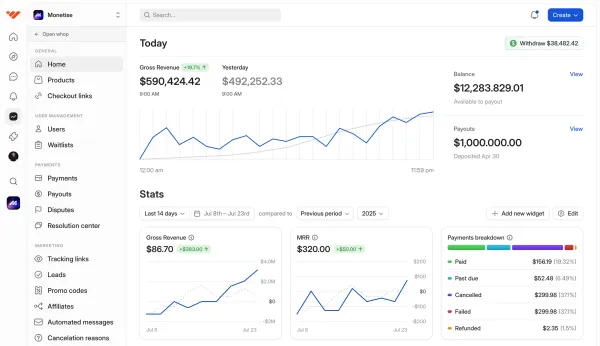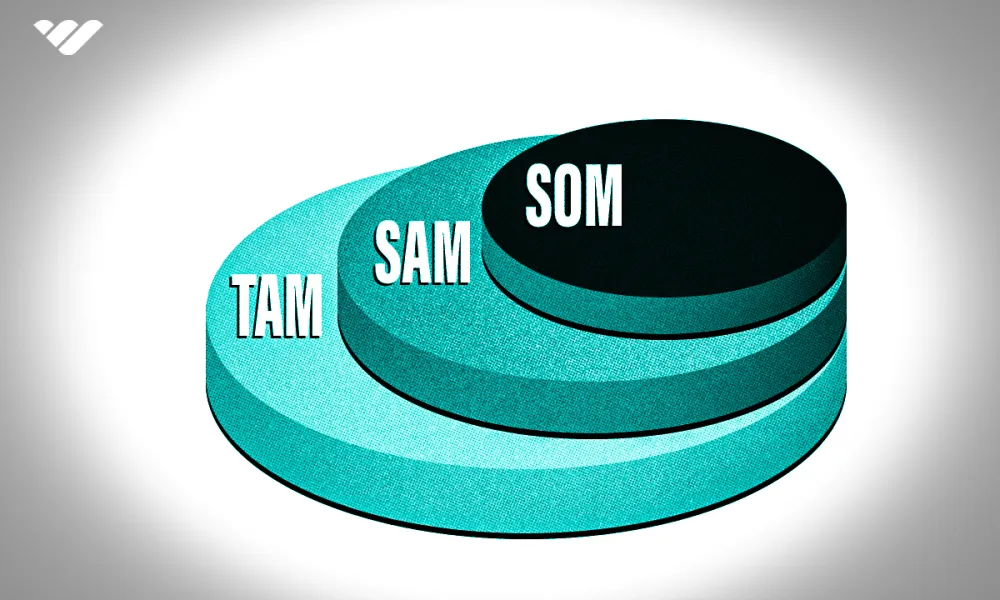You can create a marketing plan by doing a SWOT analysis, conducting customer analysis, setting your goals, developing a marketing strategy, and setting a budget. Learn more details about each step in this guide.
As a business owner or someone who’s just about to start out on an entrepreneurial journey, there’s plenty on your docket, and having a solid marketing plan is one of the most important ones.
You can create a marketing plan by:
- Doing a SWOT analysis to understand your strengths, weaknesses, opportunities, and threats
- Doing a customer analysis to understand your target audience
- Setting specific, measurable, and realistic goals
- Developing your market strategy to cover your product, price, place, and promotion
- Set a budget by defining what your marketing plan will cost, including tools, promotions, etc.
Let's see more details on creating a marketing plan, what is it, why do you need one, and some essential marketing plan sections.
How to write a marketing plan in 5 simple steps

1. Do a SWOT analysis
A SWOT analysis is a business tool that just about every company uses regularly in order to gain a high level, strategic view of what their current situation is. It’s also an easy exercise to do, since you simply have to identify and expand on your:
- Strengths
These are core to your business offering, because they outline what you’re good at. That includes any skills or competencies you might bring to the table yourself, or some sort of competitive or even absolute advantage your company is able to bring to bear. Traditionally, that meant having easy access to certain resources or contacts, but in today’s creator economy there are many more ways to differentiate yourself from the competition. - Weaknesses
The opposite of the above, weaknesses aren’t always easy to acknowledge but there’s a lot of value in doing so. It’s also not about admitting faults, but assessing the ways in which you may lag behind your competition, whether that’s through your own skill set, the capabilities of your partners, unreliable suppliers, lack of access to certain tech or resources, finances, or anything else. - Opportunities
These are ways in which your business or side hustle can move forward and boost its top and/or bottom line. A lot of your weaknesses can be spun into opportunities (partly why it’s important to outline them) and the competitive landscape could offer plenty more.
In the creator economy, for example, spreading your wings into new forms of content such as podcasts might be an opportunity, as might selling merch to your fans via print on demand. - Threats
When something has the potential to have a negative effect on your business in the future, immediate or otherwise, it qualifies as a threat. The source of a threat can also be external or internal—take car manufacturer Tesla, for example. Many of the threats they face are geo-political in nature, but their CEO Elon Musk could be considered as much of a threat as a strength now given his fading public reputation and increasingly radical antics.
As might be obvious from the descriptions of the different sections above, a SWOT analysis can actually be quite a detailed exercise and require plenty of work. The more depth you go into the better, and you can support your SWOT with other research.
Analysis of your competitors and the market as a whole can help you come up with the best possible insights, which in turn will help you immeasurably as you press ahead with your marketing plan.
Did you know you can market your brand using Whop's Content Rewards app?
2. Conduct a customer analysis

Customers are the most important aspect to just about every type of business, and the vast majority would cease to exist if they lose touch with or stop understanding what their customers want and how they behave. Entrepreneurs the world over have built empires upon a good understanding of their customers’ needs, and it’s also the entire basis for how you run any and all marketing activities.
A good customer behavior analysis will look at all of the factors around a person (or organization, if you’re running a B2B model) with regard to their purchasing habits, including their mindset, attitude, personality, and how exactly they make their buying decisions. By understanding this, and especially what goes into said purchase decision, you can start tailoring your marketing plans to fit your target customers.
Personal factors play an extremely big role in how someone consumes, and this includes the basics like demographics all the way to beliefs and morals. The ethical stance of your business and any CSR activities you do might dictate the purchase decisions of some people, as might the sort of social traffic you engage with. The old saying “all PR is good PR” may not hold true any longer if your customer analysis shows that your customers tend to value morals and ethics.
Beyond that, there are also psychological factors to consider where the perception of your brand comes into play, as well as social issues such as influence—it’s always good to know if there’s someone making buying decisions on behalf of various consumer groups, or if they’re consulting with someone before settling on a choice. Today, online influencers have a big part to play here, with some able to position themselves as experts in certain niches.
In addition to this detailed consumer behavior analysis, you’ll also want to perform an exercise known as a target persona. Essentially, you’re going to use all of your research insights to build a single customer profile that represents your customer base, essentially forming an avatar that helps you better understand how to communicate with your customers through your marketing.
3. Set your goals
Before getting to work on your marketing plan itself, it’s a good idea to spend a little while setting measurable, realistic, and achievable goals. The marketing plan isn’t just an exercise after all, you’re creating it in order to accomplish or achieve something—and that something is your set of goals.
The SMART framework can help you when you’re setting the goals of your marketing plan, and it’s simple enough to work with:
- Specific
Your goals should be specific and clearly defined, rather than being open-ended and sweeping. - Measurable
The most effective goals are measurable. For instance, you might intend for marketing to generate an increase of 5% of revenue compared to the previous year—that’s both specific and measurable. - Achievable
Ambition is a good thing, but it’s always wise to set goals that can actually be met—that’s why we used 5% in the previous example, as opposed to 50% or 500%. - Realistic
This is similar to the previous, but has more to do with the resources you have available to do. If you don’t have the required resources, hitting a given goal is an unrealistic prospect. - Time-bound
A time frame is always good to attach to a goal, and most marketing plans may look at the coming year or so.
Analytics can really help you set effective goals that fulfill all of the above criteria. Measurability for example doesn’t just have to be in terms of revenue, but also engagement—for example, your likes, follows or subscribes, shares, comments, views, and much more can be analysed in depth and broken down by services like Google Analytics. You can then set goals with them, such as increasing engagement or growing account reach by a certain amount.
And it’s not just social media that returns all of that data to you. By hooking up your website or an online store like Whop to Google Analytics, you can develop a whole bunch of extremely valuable customer insights that could be used in consumer behavior analysis and persona building.
4. Your marketing strategy
With your goals laid out clearly and objectively, it’s a lot easier to build out an effective marketing strategy that can accomplish those goals. Coming up with an entire marketing strategy is well beyond the scope of this guide, but there are some marketing rules of thumb that you might be able to use. One of the most widely used systems is the “4 Ps” of marketing:
- Product
Creating a marketing strategy needs to start with what you’re marketing. The product or service that you’re selling is central to your strategy, and your job is to define what separates it from competing products, who needs it and why, and what its lifecycle is likely to be. - Price
Once you’ve defined your product or service properly, you can begin the process of pricing it. The key here is to identify your product’s real as well as its perceived value, and also factoring in supply costs, any applicable markup, and the prevailing state of the market for similar products. - Place
This refers to where you’re going to make your product or service available to customers. Traditionally, it’d be a question of where you want to set up shop, but today we’re talking about brick and mortar versus online. And even if you go 100% online, the question of which ecommerce platform to list your business on is a nuanced one. - Promotion
Finally, your marketing strategy needs to look at how to communicate to consumers the fact that your product is right for them. Advertising and PR both come into the equation here, and there are plenty of case studies on just how crucial they can be to the long-term success of different products. You may have the best option on the market, but that matters little until you reach the eyes and ears of consumers.
When you put all of these different factors together and plug in real world information, you can start making decisions on how exactly to market your product or service. Each element of the strategy can play a big role in your overall success, and different strategies may be appropriate given your circumstances.
Pricing, for example, isn’t just a calculation based on your costs and what your competitors are doing. The way you position your product in the market could have a lot to do with things, and in fact, part of establishing yourself as a ‘premium’ option has a lot to do with hiking your price up as far as feasible.
On the other hand, introductory price is a thing too, snapping up market share even at a loss before bringing your prices up to where they need to be once you’ve got an established customer base.
5. Set your budget

Your marketing strategy probably lays out a lot of things you need to do, especially when it comes to advertising and promotion, and that’s going to cost money. That’s why budgeting is an essential part of a marketing plan—without it, everything you come up with is simply words in the wind, since it’s a budget that lets you execute everything you’ve planned.
Luckily, a marketing budget doesn’t need to be as detailed as a financial plan or your company’s accounts. What’s important is to consider every facet of your marketing and price it out as accurately as possible—you’re looking at potentially signing up for CRM tools or services, using analytics software, linking up with graphic design services, copywriters, and perhaps even ad agencies. Each one of these will have a cost attached to it.
Some consultants recommend a marketing budget of around 1% of total revenue as a rule of thumb, but that could swing up or down depending on your industry as well as your current situation. A company that’s brand new, for instance, may want to market itself more aggressively in order to get its name out there.
What is a marketing plan?
A marketing plan is a document that details the different marketing and advertising activities an organization intends to carry out during a certain time period.
The scope of a marketing plan may differ based on the size and the nature of the organization in question, but it generally goes into clear detail on how you’re going to run your acquisition and conversion strategies, with clear goals and action items.
Why do you need a marketing plan?
A marketing plan gives you a clear plan of action that can, if well executed, help you to reach the goals you have for your business. In fact, it can help you better understand your own business via different exercises and analyzes, and it can ensure that you make informed decisions given the amount of data and research you’ll have to distill in order to create your marketing plan.
The plan can also help you better align marketing goals with business goals, which doesn’t matter too much if you’re going at it alone—but the moment stakeholders are factored into the equation, such as partners, employees, investors, and others, you’ll need to start getting them to buy in. A marketing plan can go a long, long way in ensuring that everybody’s on the same page.
Essential sections in your marketing plan
How to create a marketing plan should be clear thanks to the previous section, but it’s also a good idea to structure your marketing plan effectively. Here are the different sections you could consider creating:
1. Executive summary
This section takes the lead in most plans and reports, serving as a summary of whatever’s within. Your executive summary can feature the most salient points in your marketing plan as well as the key takeaways, and while it isn’t an elevator pitch in written form per se, it can play a similar role. It’s concise and very much to the point, and gets readers intrigued enough to read further.
2. Vision, mission, and values
Your company’s vision, mission, and values are usually stated on documents like a founding charter or business plan, but they can help a lot in a marketing plan in order to give some context to it. The marketing plan, after all, aims to further the goals of the business, which are themselves in service to its greater mission. So, if any stakeholders need to know why you’re doing what you’re doing, they need just turn to this page.
3. Market research
The customer research you did earlier, along with any competitor analysis and any other research and insights you generated in the early stages of creating your marketing plan can all go here. These help even more in setting the context of what’s going on, and the SWOT analysis you did can help readers understand exactly where your business is at. It’s a good idea to visualize as much of the research here, too, to make things more digestible and easier to use in decision-making.
4. Target audience
We’ve already gone over the creation of target personas, and it’s wise to save some of that for a separate section that follows the rest of your market research. The market is one thing, but your audience and your specific niche need their own attention—and lots of it. Provide as much information as you can regarding your target market and personas here, and it’ll help inform the strategy section that follows a little bit later.
5. Marketing goals
We’ve already gone over the need to set marketing goals, and they’re very much deserving of their own dedicated section in your marketing plan. An entire page with a few goals blown up to fill it can really set the stage for how important they are, and show how the marketing strategy that follows is all about achieving these goals as stated.
6. Marketing strategy
Finally, it’s time for the real substance of your marketing plan. Everything else has its place, but your marketing strategy really details what you’re going to do on the marketing front, and exactly what steps you’re going to take in service of achieving your goals.
It goes without saying that this section needs to be as detailed as possible while also being readable, organized, and presented with as many visuals as you’re able to generate. Infographics are good, and you can use different techniques to show your strategy, such as roadmaps or timelines.
7. Marketing budget
Lastly, you’ll also want to give your marketing budget its due place of prominence within the plan. The financial side of your marketing aspirations is just as important as the inspiration behind it all, because it’s almost certain that you’ll need funds to execute.
It’s definitely possible to carry out all of your advertising and promotional activities on a shoestring, but a detailed forecast will ensure that there are no unwelcome surprises when those invoices finally land.
Perfect your marketing strategy with Whop
A marketing plan is central to the success of any business, big or small, and it’s a good idea to stay current with your own marketing knowledge given the rapid pace of progress when it comes to the different marketing channels out there, especially online ones.
That’s why Whop’s business groups are worth checking out - they’ll give you all you need to know via courses, and the many communities you’ll find can help you get in touch with others on the same sort of journey you’re on.
We also mentioned the need for the right ecommerce platform when it comes to product placement, and you’ll be well served creating your own whop.
From best-in-class digital fulfillment and all of the monetization options you’ll ever need in addition to marketing support across every stage of your strategy, a whop can transform your business for the better—and it’s free to sign up and start selling.















